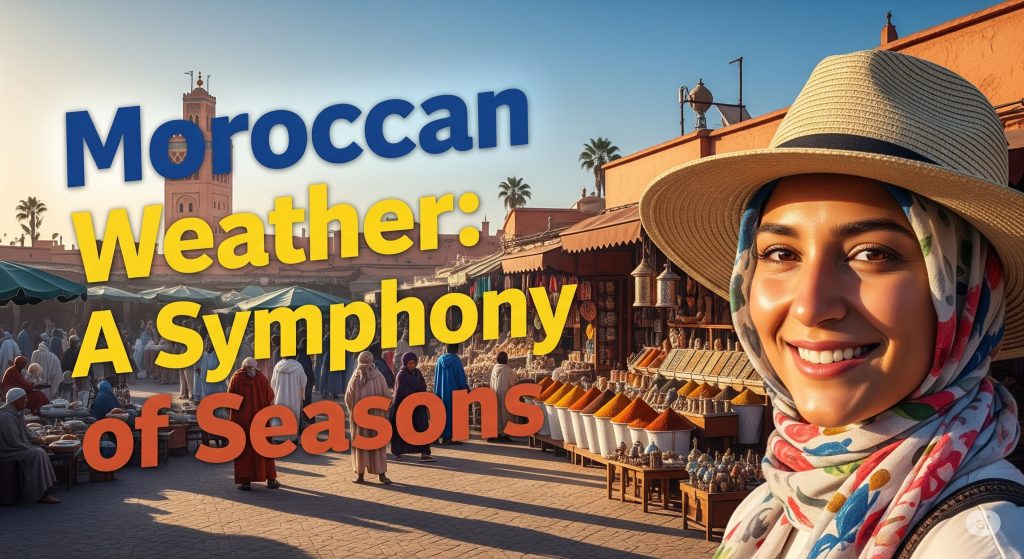Morocco, a land of enchanting contrasts, offers a climate as diverse and captivating as its landscapes and culture. Far from a monolithic hot desert, its weather weaves a rich tapestry across its varied topography, from the sun-drenched coastal plains to the snow-capped Atlas peaks and the vast, shimmering Sahara. This intricate dance of elements doesn’t just shape the land; it profoundly influences the Moroccan way of life, its architecture, its cuisine, and its very rhythm.
A Land of Microclimates: Where Every Region Tells a Different Story
One of the most remarkable aspects of Morocco’s weather is its dramatic regional variation. This is not a country where one blanket forecast applies to all. Instead, it’s a mosaic of microclimates, each offering a distinct experience:
The Atlantic and Mediterranean Coasts: The Gentle Embrace of the Sea.
Along its extensive coastline, from Tangier in the north to Agadir in the south, Morocco enjoys a delightful Mediterranean climate, heavily tempered by the ocean’s influence. Here, summers are warm but rarely sweltering, thanks to refreshing sea breezes. Cities like Essaouira are famed for their year-round cooling winds, making them a haven for watersports enthusiasts and those seeking respite from inland heat. Even in the height of summer, average daytime temperatures generally hover between 25∘C and 30∘C (77∘F to 86∘F), with evenings providing a welcome coolness. This coastal moderation allows for comfortable exploration of historic kasbahs, vibrant medinas, and pristine beaches, even in July and August. The low humidity in many parts of the coast, despite the proximity to water, adds to the comfort, preventing the oppressive stickiness found in more tropical coastal regions. The Mediterranean coast, particularly, boasts calmer waters and inviting temperatures, ideal for swimming and leisurely seaside activities.
The Imperial Cities and Central Plains: The Intensity of the Interior.
Venture inland to the imperial cities of Marrakech, Fes, and Meknes, and the climate shifts dramatically. Here, the continental influence takes over, leading to much hotter and drier summers. Daytime temperatures frequently soar above 35∘C (95∘F), often reaching 40∘C (104∘F) or higher, particularly in July and August. This intense, dry heat is a defining characteristic of a Moroccan summer for many visitors. While challenging for some, this dry heat is also often perceived as more bearable than humid heat, and it profoundly shapes local life. The clear, cloudless skies offer an almost endless expanse of brilliant blue, giving way to spectacular sunsets that paint the horizon in fiery hues. Nights in these regions, while still warm, offer a noticeable drop in temperature, making evenings a time for leisurely strolls, vibrant market visits, and rooftop dining as the city truly comes alive.
Related article : Agadir in Autumn: A Symphony of Golden Hues and Gentle Breezes
The Majestic Atlas Mountains: Alpine Retreats and Crisp Air.
Running like a spine through the country, the Atlas Mountains present yet another climatic extreme. At higher altitudes, the climate is considerably cooler and more temperate, even during summer. While the lower slopes can experience warm days, trekking in the High Atlas offers a refreshing escape, with daytime temperatures ranging from 20∘C to 30∘C (68∘F to 86∘F). The air is crisp and clean, and the sparse vegetation gives way to lush valleys and occasional snow-capped peaks well into early summer. This region provides a vital sanctuary for both locals and visitors seeking relief from the summer sun, offering opportunities for hiking, exploring Berber villages, and enjoying the serene beauty of mountain landscapes. Evenings are distinctly cool, often requiring a light jacket, a stark contrast to the heat of the plains.
Related article : Taghazout: Where the Atlas Embraces the Atlantic
The Sahara Desert: The Scorching Heart and Star-Filled Nights.
Finally, the dramatic, sprawling Sahara Desert in the south embodies Morocco’s most extreme summer weather. Here, temperatures are truly formidable, regularly exceeding 45∘C (113∘F) and sometimes touching 50∘C (122∘F). The heat is relentless, but it is also a dry, pure heat that, for some, holds a unique allure. The desert sky is almost always clear, offering uninterrupted sunshine during the day and, perhaps most beautifully, an astonishing spectacle of stars at night. The absence of light pollution transforms the night sky into a dazzling, infinite canvas, a truly humbling experience. Despite the daytime intensity, desert nights bring a significant temperature drop, often falling to 25∘C (77∘F) or lower, making evenings under the vast, sparkling sky surprisingly comfortable and utterly magical. This intense environment has also given rise to unique traditional healing practices, like sand bath therapy, where the sun-baked sands of Merzouga are used for their therapeutic properties.
The Beauty Beyond the Thermometer: How Weather Shapes Life
The beauty of Moroccan weather extends far beyond mere temperature readings; it is deeply interwoven with the country’s cultural fabric and daily rhythms.
Architectural Ingenuity and Climate Adaptation:

Traditional Moroccan architecture is a testament to centuries of adaptation to the climate. Riads, with their enclosed courtyards and high walls, are marvels of passive cooling. The central courtyard, often featuring a fountain or pool, creates a natural microclimate, drawing hot air upwards and allowing cooler air to circulate, providing shade and evaporative cooling. Thick walls made of natural materials like rammed earth, stone, and terracotta absorb heat during the day and slowly release it at night, contributing to a cooler indoor environment. Intricate mashrabiya screens filter harsh sunlight while allowing for airflow, maintaining privacy, and adding aesthetic beauty. These design principles mean that even without modern air conditioning, traditional homes offer a remarkable refuge from the summer heat, fostering a sense of calm and coolness within.
The Rhythm of Life: Siestas and Nocturnal Vibrancy:
The summer heat dictates a unique pace of life, particularly in inland cities. Midday often brings a quieter rhythm, with many shops closing for an extended siesta from around 12 PM to 5 PM. This is not a sign of laziness but a sensible adaptation, encouraging rest during the most intense heat. As the sun begins to set, cities reawaken with a renewed energy. Cafes fill, markets bustle, and streets come alive with families and friends enjoying the cooler evening air. This nocturnal vibrancy is a quintessential part of the Moroccan summer experience, a time for socialising, dining outdoors, and soaking in the lively atmosphere under a star-studded sky.
The Oasis of Gardens and Water Features:
In a land often characterized by aridity, Moroccan gardens are exquisite havens, designed to offer sensory refreshment and respite from the sun. Drawing heavily from Islamic and Moorish traditions, these gardens, whether private riad courtyards or grand public spaces, often feature intricate water rills, fountains, and reflective pools. These elements provide not only aesthetic beauty but also crucial evaporative cooling. The shade provided by citrus trees, palms, and other lush foliage creates inviting pockets of coolness. These gardens are living testaments to human ingenuity in harmonizing with nature, transforming dry landscapes into verdant paradises.
Culinary Comforts and Refreshing Rituals:
Moroccan cuisine also adapts to the summer climate. Light, refreshing salads, abundant fresh fruits (especially watermelons and melons), and cooling beverages like mint tea are staples. Mint tea, served hot, paradoxically helps the body regulate its temperature and promotes sweating, a natural cooling mechanism. The emphasis on slow-cooked tagines and stews, often prepared in earthenware pots, allows for meals that are satisfying but not heavy, enjoyed in the shaded coolness of homes or riads.
You might be interested in reading : Discovering Agadir: A Guide to the Jewel of the Souss-Massa Region
The Enduring Allure for Travelers:
While some might shy away from the heat, summer in Morocco offers unique advantages for the discerning traveler. It’s often considered the “low season” for international tourism, meaning fewer crowds and potentially better deals on accommodations and tours. This allows for a more authentic immersion in local culture, with greater opportunities to interact with Moroccans who are often on their own summer vacations along the coast. Summer is also festival season, with world-renowned music festivals adding a vibrant cultural dimension to the experience.
Conclusion
The beauty of the weather in Morocco is not just about the sunshine, though its abundance is undeniable. It’s about the intricate ways the climate shapes a diverse land and its resilient people. It’s in the refreshing coastal breezes that dance off the Atlantic, the intense dry heat of the interior that clears the mind, the crisp mountain air that invigorates, and the profound silence of the desert nights under a blanket of stars. It’s in the ancient architectural wisdom that keeps homes cool, the relaxed rhythm of the midday siesta, the joyous energy of the cool evenings, and the lush tranquility of shaded gardens. Moroccan weather is an experience, a living, breathing force that sculpts the landscape, influences human endeavor, and ultimately, contributes to the unparalleled charm and enduring allure of this North African jewel.
Further read : Morocco’s Azure Embrace: A Guide to Swimming on Its Stunning Coasts
Planning your trip to Morocco ? Contact us now to reserve your seat


Pingback: A Guide to Swimming on Morocco's Stunning Coasts
Pingback: Taghazout: Where the Atlas Embraces the Atlantic - Tasga
Pingback: The Allure of Autumn HOLIDAYS in Morocco - Tasga
Pingback: Agadir in Autumn: A Symphony of Golden Gentle Breezes